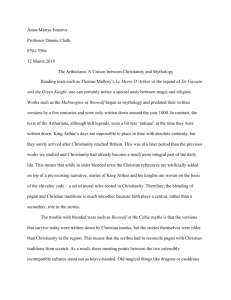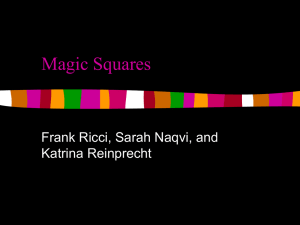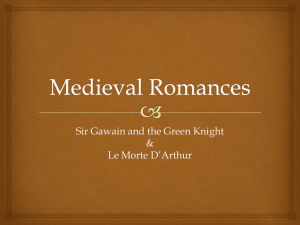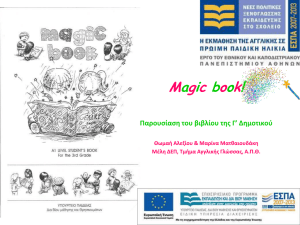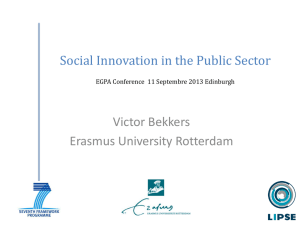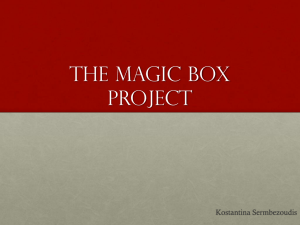ADelale, Revision RP 2
advertisement
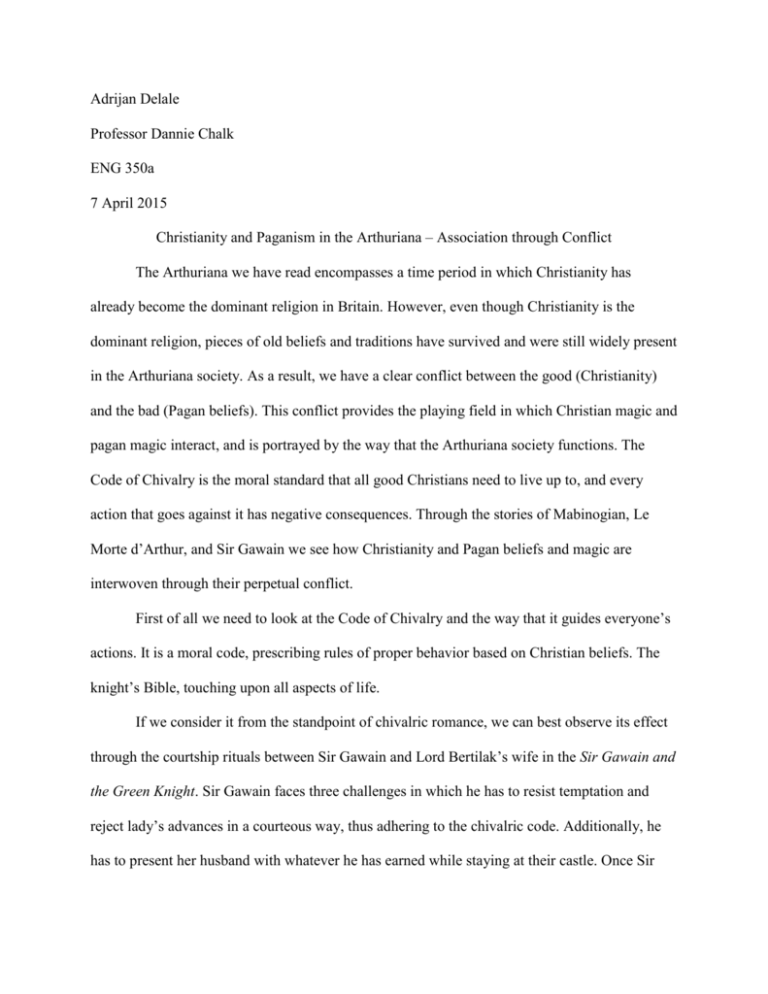
Adrijan Delale Professor Dannie Chalk ENG 350a 7 April 2015 Christianity and Paganism in the Arthuriana – Association through Conflict The Arthuriana we have read encompasses a time period in which Christianity has already become the dominant religion in Britain. However, even though Christianity is the dominant religion, pieces of old beliefs and traditions have survived and were still widely present in the Arthuriana society. As a result, we have a clear conflict between the good (Christianity) and the bad (Pagan beliefs). This conflict provides the playing field in which Christian magic and pagan magic interact, and is portrayed by the way that the Arthuriana society functions. The Code of Chivalry is the moral standard that all good Christians need to live up to, and every action that goes against it has negative consequences. Through the stories of Mabinogian, Le Morte d’Arthur, and Sir Gawain we see how Christianity and Pagan beliefs and magic are interwoven through their perpetual conflict. First of all we need to look at the Code of Chivalry and the way that it guides everyone’s actions. It is a moral code, prescribing rules of proper behavior based on Christian beliefs. The knight’s Bible, touching upon all aspects of life. If we consider it from the standpoint of chivalric romance, we can best observe its effect through the courtship rituals between Sir Gawain and Lord Bertilak’s wife in the Sir Gawain and the Green Knight. Sir Gawain faces three challenges in which he has to resist temptation and reject lady’s advances in a courteous way, thus adhering to the chivalric code. Additionally, he has to present her husband with whatever he has earned while staying at their castle. Once Sir Gawain succumbs to temptation, and accepts the magic girdle without presenting it to Lord Bertilak upon his return from the hunt, he goes against the principles of the chivalric code. This moment in the story marks the beginning of Sir Gawain’s divergence from the Christian ideals and puts a stain on his further actions. Sir Gawains’s actions lead to a conflict between Christian and pagan magic. His decision to wear the girdle when confronting the Green Knight symbolizes his acceptance of pagan magic that the girdle possesses, and demonstrates a lack of belief in Christianity and the power that Christian magic provides. In this case, Christian magic is represented by his armor, enchanted by Christian magic, and the Christian symbols that he wears to the confrontation, such as the pentangle on his shield (symbol of Solomon, five points representing devotion to the five wounds of Christ, among other things). Because Sir Gawain embraces the pagan symbol, and seeks protection from the pagan magic that the girdle holds, his actions, no matter how brave and honorable, are stained by shame. After the confrontation with the Green Knight, Sir Gawain acknowledges his mistake and chooses to openly display his shame by wearing the girdle, as a form of redemption for his actions. Second of all we need to look at the nature of the magic in Arthuriana, mainly what constitutes good magic and what constitutes evil magic. On one side we have Merlin, who uses his magic openly and in the pursuit of Christian ideals – mainly by assisting characters such as Arthur, who are living by the Chivalric code. On the other side we have Morgan le Fey who uses her magic to deceive and cheat, and she uses it for petty reasons such as jealousy. None of her actions adhere to the Chivalric code. We can observe this from her use of magic in the Sir Gawain and the Green Knight, where she uses her magic to enchant Lord Bertilak with the intent to deceive King Arthur’s court and scare Guinevere. Based on the general portrayal of these two characters, Merlin as a force of good and Morgan le Fay as a force of evil, we can make a distinction between these two types of magic. Merlin’s magic, which is done openly and for chivalric reasons represents the good Christian magic, while Morgan le Fay’s deceitful use of magic represents the evil pagan sorcery. When these conflict, Christian magic prevails and Pagan sorcery is always defeated in the end. Finally, we must observe the Christian motif of redemption in these stories. Redemption follows the outcome of the conflicts between Christianity and paganism. As Christianity triumphs, those who had strayed from the righteous path realize the error of their ways and seek absolution. We can observe this behavior in Le Morte d’Arthur, in the affair between Lancelot and Guinevere. By running away with Arthur’s wife, Lancelot breaks the Chivalric code and chooses to live in sin with Guinevere. Their actions eventually lead to the fall of Camelot, and once Lancelot and Guinevere realize the error of their ways, they choose to commit their lives to the church as a form of penance for their sins. We also see the motif of redemption in Sir Gawain and the Green Knight, as discussed above, when Gawain chooses to openly display his shame by wearing the girdle after his confrontation with Lord Bertilak. Redemption follows as a natural succession of events in the Arthuriana, and it demonstrates the triumph of Christian beliefs and Christian magic over paganism. To conclude, Christianity’s dominance has created a society in which every action and social interaction is weighted against Christian values. As a result, the Arthuriana is filled with conflicts between Christianity and paganism which portray the interaction and integration of Christian and pagan traditions. The Chivalric code, based on Christian values, represents the standard to which everyone needs to adhere to, and every action that deviates from it has bad consequences. In the end, Christianity prevails over paganism; those who have strayed from the path of Christianity realize the error of their ways and seek redemption; and pagan beliefs get either replaced by, or adjusted to the Christian values.
